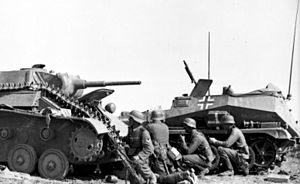Fall Blau
| Case Blue — German summer offensive of 1942 | |||||||
|---|---|---|---|---|---|---|---|
| Part of the Eastern Front of World War II | |||||||
 German troops take cover behind a knocked out T-70 light tank and beside a Sd.Kfz. 250 halftrack, summer 1942 |
|||||||
|
|||||||
| Belligerents | |||||||
|
|
|||||||
| Commanders and leaders | |||||||
| Strength | |||||||
|
|
||||||
| Casualties and losses | |||||||
| 1,013,000 |
|
||||||
Case Blue (German: Fall Blau), later renamed Operation Braunschweig, was the German Armed Forces' (Wehrmacht) name for its plan for the 1942 strategic summer offensive in southern Russia between 28 June and 24 November 1942.
The operation was a continuation of the previous year's Operation Barbarossa, intended to knock the Soviet Union out of the war, and involved a two-pronged attack against the oil fields of Baku as well as an advance in the direction of Stalingrad along the Volga River, to cover the flanks of the advance towards Baku. For this part of the operation, Army Group South (Heeresgruppe Süd) of the German Army was divided into Army Groups A and B (Heeresgruppe A and B). Army Group A was tasked with crossing the Caucasus mountains to reach the Baku oil fields, while Army Group B protected its flanks along the Volga.
Initially, the offensive saw gains, with an advance into the Caucasus capturing large areas of land and several oil fields. However, the Red Army defeated the Germans at Stalingrad, following Operations Uranus and Little Saturn. This defeat forced the Axis to retreat from the Caucasus. Only the city of Kursk and the Kuban region remained tentatively occupied by Axis troops.
...
Wikipedia
